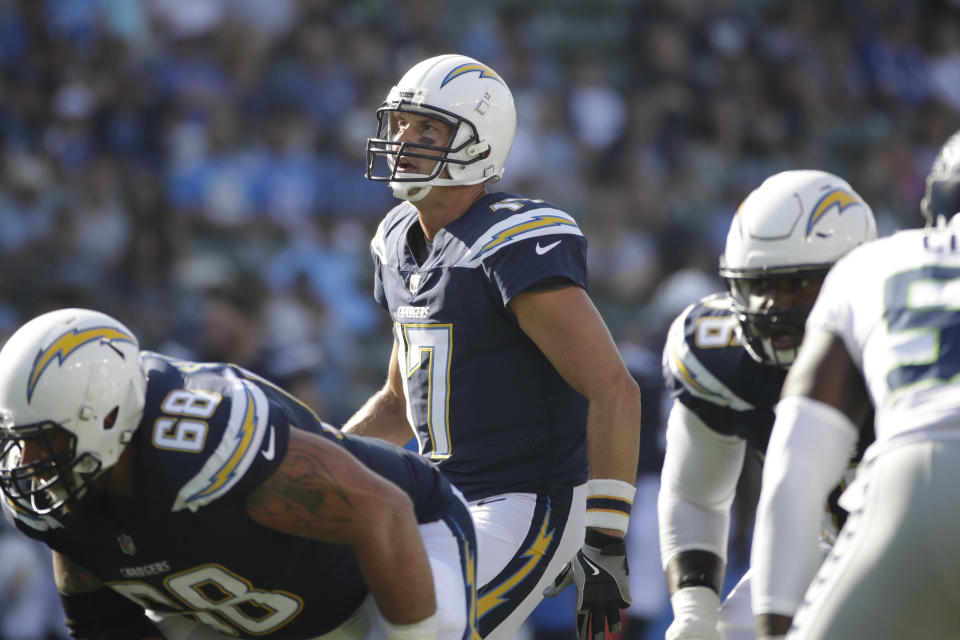Juggernaut Index, No. 14: Chargers offer fantasy delights in Gordon, Allen, Rivers

Chargers quarterback Philip Rivers enters the 2017 season ranked eighth all-time in passing touchdowns (314), tenth in completions (3811) and twelfth in passing yardage (45,833). By the end of the year, his name will very likely be among the top 6-8 on each list. Additionally, Rivers currently ranks eighth in career passer-rating (94.7), tenth in completion percentage (64.4) and fourteenth in yards per attempt (7.7). He passed for 4386 yards and 33 TDs last season, so he remains plenty productive at age 35.
[Pick One Winner A Week. Play Survival Football for chance at $100K]
When all the numbers are in, Rivers might very well have 60,000 passing yards and nearly 400 touchdowns to his credit, which should give him a compelling Hall of Fame argument. But at no point in Rivers’ career has he been widely recognized as a top-three player at his position — not even in his best years, 2008-10, when he averaged a ridiculous 8.6 Y/A. He’s earned six Pro Bowl nods and occasional Offensive Player of the Week recognition, but the big awards have eluded him. He led his team to just one conference championship game, losing 21-12 to Tom Brady in Foxborough, failing to throw a touchdown pass.
Of course none of these details are relevant to Rivers as a fantasy asset in 2017, but he happens to be an interesting figure in the game’s history. For you, maybe he’s an inner circle member of the Hall of Not Quite. For others, he’s unquestionably one of the best 15-or-so passers the NFL has ever seen, clearly Canton-worthy. It’s a discussion.
One thing we can say with certainty about Rivers is that he’s been an under-appreciated and routinely under-drafted fantasy commodity. The man hasn’t missed a game in 11 years. He’s averaged 4486 passing yards and 31 touchdowns per season since 2013. He threw multiple TD passes in each of his final nine games last year. Even now, with Rivers beyond his prime, you can win a fantasy title with this man as your every-week QB. He’s selected outside the top-100 picks in standard Yahoo drafts (ADP 109.8), later than players who’ve never produced at the level he reached last season. If you’re looking for a quarterback who can deliver top-eight numbers at a deep discount (and you should be), then Rivers is your guy.
There are flaws in Rivers’ fantasy game, to be sure. He’s led the league in interceptions in two of the past three seasons and he has the mobility of a fantasy expert, not an NFL athlete. But in fairness to Rivers, over the past three seasons it feels like he’s introduced to a new cast of receivers each week. His most trusted options have been only sporadically available.
And still Rivers keeps going, flinging the ball with that ugly-yet-effective sidearm delivery that no young quarterback should be allowed to watch. Rivers’ completion percentage dipped last season, but his deep ball attempts per game jumped from 3.7 to 4.9 and his air yards per attempt from 3.2 to 4.1. He has continuity in the coaching staff, with Ken Whisenhunt back as OC, and his receiving corps is uncharacteristically healthy at the moment. If you can land him outside the top-10 quarterbacks in your draft, it’s a steal.
So … Keenan Allen. Can he be trusted?
Look it’s the NFL. No player can be fully trusted. Everyone is at risk. Allen has obviously been dinged more than most, having appeared in just nine games over the past two seasons. In 2015 it was a lacerated kidney, which, while gross, was not necessarily an injury with career-altering potential. But in 2016, Allen suffered an ACL tear in the first half of the season opener; it’s reasonable to worry about his return to full health on a 12-month timeline. Not every athlete bounces back from ACL repair like Adrian Peterson.
That said, all the reports on Allen’s recovery have been generally positive, with no less an authority than Rivers declaring, “He looks as good as he did before he got hurt.” So that’s encouraging. If we take Allen’s per-game production over the past two years and extend it over 16 weeks, we get this insane line: 171 targets, 130 receptions, 1401 yards, seven TDs. Allen has been the preferred target for Rivers since entering the league, and he’s somehow still just 25 years old. It should go without saying that Allen presents us with elevated injury risk, but his statistical ceiling is also unusually high. Early drafters have done a fair job pricing his range of potential outcomes, selecting him as the No. 23 receiver off the board (ADP 52.7). The Yahoo crew ranks him as high as WR10 (Loza) and as low as WR26 (Pianowski, Del Don). If everything goes right for Allen (which rarely happens for anyone), a top-10 positional finish is definitely in play.
The Chargers used the seventh overall selection in last spring’s draft on Clemson receiver Mike Williams, a 6-foot-4 wideout who lacks elite speed and separation ability, but possesses exceptional ball-tracking skills and body control. He made a few degree-of-difficulty grabs against exceptional collegiate defenses, in the biggest moments. He has a clear chance, long term, to be a 1000-yard receiver with big-play ability. For now, however, Williams is on the PUP list, dealing with a herniated disk in his back and unlikely to get in meaningful practices in camp. It would be a significant surprise if we see him in opening week, and we can’t rule out the possibility that he’ll miss a huge chunk of his first pro season. In non-dynasty leagues, he’s little more than a final-round flier. (And honestly, you should be able to find a healthier and more appealing lottery ticket.) It just wouldn’t feel like a normal Chargers season if every receiver was healthy.
Fortunately for this team, Mike Williams never seemed like a lock to open the year as the No. 2 receiving option, nor as the No. 1 Williams. Let’s not forget the season Tyrell Williams delivered in 2016, when injuries elsewhere created a path to meaningful targets. Tyrell hauled in 69 balls on 120 chances, gaining 1059 yards and reaching the end-zone seven times. He produced three 100-yard games and finished with at least 60 yards 11 times. At 6-foot-4, Williams is a size/speed combo player who’s averaged 16.2 yards per reception over his two seasons. He was a revelation last year, and he deserves a bit more respect from fantasy drafters (ADP 101.8). He may not quite reach last year’s target total while Allen remains healthy, but he can still expect 100-plus. He won’t be challenged by Mike Williams any time soon.
Travis Benjamin is the only other Chargers wideout who needs to be on anyone’s radar for fantasy purposes, and he’s substantially more interesting in best-ball formats and those scoring for return yards. Benjamin had a pair of early 100-yard performances last season, but ended his year with just 47 catches for 677 yards and four scores. He’s not an ideal fantasy option, obviously, except in deep/odd leagues.
Hunter Henry has leapfrogged Antonio Gates in this team’s tight end hierarchy, but we can expect both players to have value in the season ahead (Henry’s second, Gates’ fifteenth). Last year, this pair combined for 89 receptions, 1026 yards and a Gronk-ish 15 scores on 146 targets. If we could have merged these two, it would have been an all-time fantasy season. Henry and Gates have been described as the No. 1 and 1A tight ends for this team, and that feels like the right way to project the pair. Fortunately, Rivers wears out his tight ends, particularly in the red zone. Gates finished with the second-most RZ targets at his position last year (22), and Henry tied for seventh (17). Expect something like 80-85 targets for Henry and 55-60 for Gates, and draft accordingly. It’s not a given that Henry’s TD total will regress; that kid is a talent, and his opportunities will clearly increase.
How high is too high for Melvin Gordon?
After a forgettable rookie season in which Gordon couldn’t unlock the end-zone’s mysteries (217 touches, 0 TDs), he suddenly couldn’t stop scoring in 2016. Gordon delivered a dozen touchdowns on 295 touches, gaining 1416 yards from scrimmage. He averaged less than 4.0 YPC for the second straight season, however, which is a small concern. His yards after contact per touch wasn’t anything special (1.1) and, according to Player Profiler, he gained just 4.4 yards per carry against light defensive fronts. Not good.
[Now’s the time to sign up for Fantasy Football! Join for free]
But touchdowns and yards still pay the fantasy bills. Gordon finished as the No. 8 running back in standard fantasy leagues in 2016, despite missing nearly a quarter of the season with a knee injury. He enters this season healthy, unrivaled on the depth chart and with an unobstructed path to a zillion touches. Or, say, 350. His primary handcuff appears to be Branden Oliver, with Kenjon Barner also lurking on the depth chart. (aggressively on Russell Okung in the offseason. L.A. also drafted offensive linemen in the second, third and sixth rounds, but early selection Forrest Lamp has been lost for the season with a torn ACL.
Bottom line, it’s tough to argue that Gordon doesn’t deserve his late first-round ADP (10.6). He has the setup necessary for another double-digit TD season.
Are we drafting L.A.’s defense?
Drafting, no. Streaming, sure. This group ranked well in fantasy last season, thanks to 18 picks and a pile of defensive TDs. In reality, however, this defense was middle-of-the-pack in terms of yards allowed and it finished No. 29 in scoring (26.4 PPG). Joey Bosa was excellent, totaling 10.5 sacks in only 12 games and emerging as an IDP to target. The Chargers don’t face a terrifying schedule, plus they get friendly December matchups with the Browns and Jets. You might just find a use for this group in the money weeks.
2016 Offensive Stats & Ranks
Points per game – 25.6 (9)
Pass YPG – 262.4 (8)
Rush YPG – 94.4 (28)
Yards per play – 5.6 (12)
Plays per game – 63.4 (17)
—
Previous Juggernaut Index entries: 32) NY Jets, 31) San Francisco, 30) Cleveland, 29) LA Rams, 28) Baltimore, 27) Chicago, 26) Minnesota, 25) Detroit, 24) Denver, 23) Jacksonville, 22) Buffalo, 21) Philadelphia, 20) Miami, 19) Indianapolis, 18) Kansas City, 17) Washington, 16) NY Giants, 15) Tennessee, 14) LA Chargers


